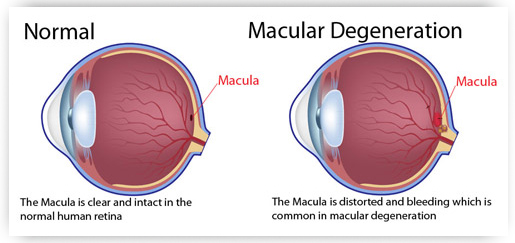
Age-related macular degeneration affects more than 1.75 million individuals in the United States on an annual basis. Most are told there is no help for their condition. Fortunately, MicroAcupuncture is an effective treatment that has helped many suffering from macular degeneration and other vision disorders.
The Macula is in the center of the retina, it’s the part of the eye we look out from. There is a heavy concentration of cones in this area that allows for more detailed vision. Macular degeneration is a condition that causes the cells in the macula to deteriorate. The deterioration of these cells causes vision loss. What starts as a small blurry spot can enlarge over time leaving the patient with only peripheral vision. Imagine holding a hand right in front of your eyes; you can see around it, but that’s all you can see.
Macular degeneration is caused by the build-up of amyloid-beta plaques in the back of the eye. Amyloid-beta plaques are the same substance that causes Alzheimer’s disease. Additionally, patients with age-related macular degeneration often have fatty deposits called “druzen deposits” that build up in the retina.
Your eyes require normal blood circulation for nourishment and healthy regeneration of cells. The capillaries that bring nourishment to the eyes allowing for normal regeneration are very small. If these tiny blood vessels are damaged or blocked for any reason, regeneration of cells is limited. In the absence of regeneration from normal blood flow, there is degeneration. We are told that there are two types of macular degeneration, “dry” and “wet.” However, there is only one type. Dry macular degeneration refers to the disease. Wet macular degeneration is a progression of the disease. About fifteen percent of cases of dry progress to wet.
In a healthy eye there is a barrier that prohibits blood vessels from growing through the retina. The barrier breaks down in the presence of macular degeneration. These new, abnormal blood vessels tend to be weak and can leak fluid into the vitreous, gel in the eye that keeps the eyeball from collapsing. When leaking occurs the patient may lose vision very quickly. It is the presence of abnormal blood vessels that determines the diagnosis of wet AMD, not the leaking of fluid. Some patients will never leak fluid even though they have wet AMD.
When blood vessels are leaking the patient may experience wavy lines in the visual field. Conventional medicine may be necessary to stop the leaking or bleeding. Patients receiving Avastin, Lucentis or laser therapy can be treated with acupuncture, while undergoing these injections or laser. Restoring normal blood circulation with MicroAcupuncture can help the eye heal.
When a patient with wet AMD has active leaking but is not a candidate for conventional interventions such as Visudyne or Lucentis, the treatments can help to restore vision by aiding the eye in the natural cleansing process. Supplements and proper diet help to strengthen blood vessels in patients with wet AMD, such as avoiding cold foods, icy drinks, spicy foods and artificial sweetener, and eating foods high in vitamin K, such as kale and alfalfa.

